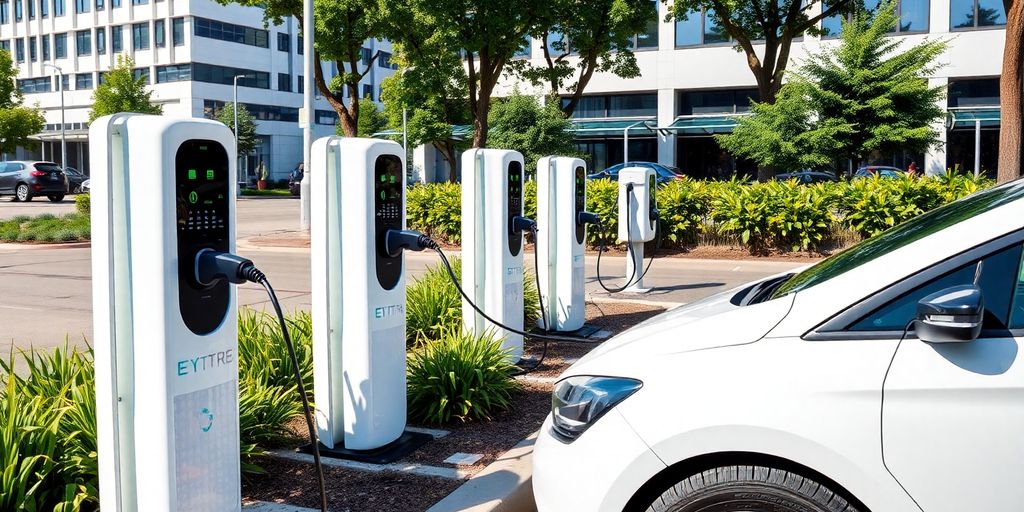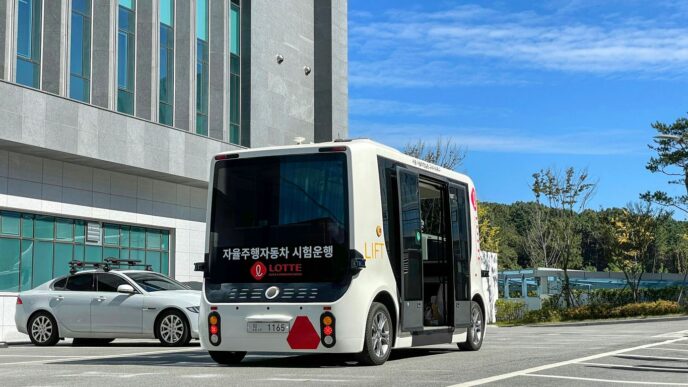As the world shifts towards electric vehicles (EVs), the need for a strong charging infrastructure becomes increasingly important. This article explores the current trends, challenges, and innovations in EV charging, as well as the roles of government and private sectors in building a reliable network. Understanding these components is crucial for ensuring that all drivers have access to the charging facilities they need.
Key Takeaways
- The federal government is investing heavily in EV infrastructure, aiming for 500,000 new chargers by 2030.
- Battery costs are decreasing, which will likely boost EV sales and charging station demand.
- Standardizing charging stations will help improve user experience and access for all drivers.
- Technological advancements like wireless charging and robotic recharging are on the horizon.
- A robust charging network is essential to meet the needs of both urban and rural drivers.
Market Trends and Future Outlook for Electric Vehicle Charging Infrastructure
Federal Government Initiatives
The federal government is taking strong steps to boost the electric vehicle (EV) market. This includes new vehicle fuel economy standards and updated greenhouse gas standards. The Infrastructure Investment and Jobs Act of 2021 is also a key part of this push, aiming to electrify federal fleets and improve charging access for everyone.
Declining Battery Costs
As battery costs continue to drop, more people are likely to buy electric vehicles. Although supply chain issues have slowed this trend recently, experts believe that prices will keep falling in the long run. This will make EVs more affordable and attractive to consumers.
New Technologies in Battery Efficiency
Innovations in battery technology are on the rise. For example, solid-state batteries could be lighter, last longer, and charge faster than current options. These advancements will not only improve the performance of electric vehicles but also help reduce costs.
The future of electric vehicles depends on making charging accessible and affordable for all drivers.
In summary, the growth of electric vehicle charging infrastructure is driven by government initiatives, decreasing battery costs, and exciting new technologies. Meeting the needs of all drivers is essential for a successful transition to electric vehicles.
Challenges in Expanding Electric Vehicle Charging Infrastructure
Access and Equity Issues
One of the biggest challenges in expanding EV charging infrastructure is accessibility. Currently, about 50,000 EV charging stations exist in the U.S., but only 17% are located on non-urban roads. This means that many people, especially those in rural areas, may live more than six miles from a charging station. To address this, we need to ensure that charging stations are available in both urban and rural areas, making it easier for everyone to charge their vehicles.
Standardization of Charging Stations
Another significant hurdle is the standardization of charging stations. All federally funded stations must meet specific national standards set by the Federal Highway Administration. These standards include:
- Consistent plug types and power levels
- Publicly accessible data on price and availability
- A single identification method for all chargers
- High uptime reliability, ensuring chargers are operational 97% of the time
Installation and Maintenance
Finally, the installation and maintenance of charging stations present challenges. Many stations need to be strategically placed to meet the needs of different drivers. For instance, urban drivers often lack home chargers and require more public stations, while rural drivers may need fast chargers spaced farther apart. Additionally, ensuring that these stations are reliable and well-maintained is crucial, as studies show that about 20% of EV drivers experience charging failures at public stations.
Addressing these challenges is essential for creating a robust EV charging network that meets the needs of all drivers, regardless of where they live.
The Role of Federal and State Policies in EV Charging Infrastructure
The Infrastructure Investment and Jobs Act
The Infrastructure Investment and Jobs Act (IIJA) is a major federal initiative aimed at enhancing the electric vehicle (EV) charging network across the United States. This act allocates $7.5 billion to develop a national network of 500,000 public EV chargers by 2030. This funding is crucial for addressing the growing demand for charging stations as more people switch to electric vehicles.
National Electric Vehicle Infrastructure Program
The National Electric Vehicle Infrastructure (NEVI) Program is a key component of the IIJA. It prioritizes funding for charging stations in underserved communities and along major highways. This program is designed to ensure that all states, including Washington D.C. and Puerto Rico, receive support to build out their charging infrastructure.
State-Level Initiatives
States are also taking action to support EV charging infrastructure. Many states have introduced their own programs to complement federal efforts. These initiatives often include:
- Incentives for private sector investments in charging stations.
- Grants and loans for local governments to build charging infrastructure.
- Public awareness campaigns to educate residents about the benefits of EVs and available charging options.
Investing in EV infrastructure is not just about building chargers; it’s about creating a sustainable future for transportation.
In summary, federal and state policies play a vital role in shaping the future of EV charging infrastructure. With the right support and funding, we can create a robust network that meets the needs of all drivers, ensuring equitable access to charging stations across the country.
Technological Innovations in EV Charging
Bidirectional Charging
Bidirectional charging allows electric vehicles (EVs) to not only draw power from the grid but also send energy back. This means that EVs can act as energy storage units, helping to stabilize the grid during peak demand. This technology can significantly enhance energy efficiency and reduce costs for consumers.
Wireless Charging
Wireless charging is an exciting development that uses electromagnetic fields to transfer energy. This means that EVs can charge without needing to plug in. Pilot projects are testing this technology, which could allow cars to charge while driving over special roadways. However, challenges like high costs and slow charging speeds still need to be addressed.
Robotic Recharging
Robotic recharging systems are being developed to automate the charging process. These systems can connect to EVs without human intervention, making charging easier and more convenient. This innovation could be a game-changer for busy drivers who need quick and efficient charging solutions.
Summary of Innovations
| Technology | Benefits | Challenges |
|---|---|---|
| Bidirectional Charging | Energy efficiency, cost reduction | Requires advanced infrastructure |
| Wireless Charging | Convenience, potential for dynamic charging | High installation costs, slow speeds |
| Robotic Recharging | Automation, ease of use | Development and reliability issues |
The future of EV charging is bright, with innovations that promise to make charging faster, easier, and more efficient for everyone.
These technological advancements are crucial for the growth of electric vehicles and the overall success of the EV market. As we continue to innovate, the landscape of EV charging will evolve, making it more accessible and user-friendly for all drivers, including those looking for the best electric car options.
Importance of Developing a Robust EV Charging Network
As electric vehicles (EVs) become more popular, having a strong charging network is essential. A well-developed charging network helps meet the needs of drivers and supports the growth of EVs. Here are some key points to consider:
Consumer Demand and Range Anxiety
- Range anxiety is a common concern for potential EV buyers. They worry about running out of battery without a nearby charging station.
- A robust network can ease these fears by ensuring that charging stations are available in many locations.
- More charging options can lead to increased EV sales, as consumers feel more confident in their ability to charge their vehicles.
Public and Private Fleet Needs
- Businesses with electric fleets need reliable charging solutions to keep their operations running smoothly.
- A strong charging network supports both public and private fleets, ensuring they can charge efficiently and effectively.
- This is especially important for delivery services and public transportation, which rely on quick turnaround times.
Equitable Access to Charging Stations
- It’s crucial that charging stations are accessible to everyone, including those in low-income and underserved areas.
- A fair distribution of charging stations can help ensure that all communities benefit from the transition to electric vehicles.
- This includes placing stations in urban areas where many people live without home charging options.
A strong EV charging network is not just about convenience; it’s about creating a sustainable future for everyone.
In summary, developing a robust EV charging network is vital for addressing consumer concerns, supporting business needs, and ensuring equitable access for all. By focusing on these areas, we can pave the way for a cleaner, more efficient transportation system.
Standardization and Design of Charging Stations
Interoperability Requirements
Standardizing charging stations is crucial for user convenience. Currently, charging stations are owned by various companies, leading to different charging experiences. This lack of standardization can confuse users, especially those who are not tech-savvy. To improve this, charging stations should have:
- Common payment methods: Support for credit cards, mobile apps, and RFID cards.
- Consistent connector designs: While the J1772 connector is common, it is not universal.
- Clear signage: Easy-to-read signs to guide users to charging points.
Network Connectivity
Charging stations must be connected to a reliable network to ensure smooth operation. This includes:
- Data collection capabilities: To monitor usage and performance.
- Real-time updates: Informing users about station availability and charging status.
- Customer support services: Accessible help for users facing issues.
Customer Support Services
To enhance user experience, charging stations should provide:
- 24/7 customer support: Assistance available at all times.
- User-friendly apps: Easy navigation and payment options.
- Feedback mechanisms: Allowing users to report issues and suggest improvements.
A well-designed charging station not only improves user experience but also encourages more people to adopt electric vehicles.
Conclusion
In summary, the standardization and design of charging stations are essential for the growth of electric vehicle infrastructure. By focusing on interoperability, network connectivity, and customer support, we can create a more user-friendly environment for EV drivers. This will ultimately lead to increased adoption of electric vehicles and a more sustainable future.
The Impact of EV Charging Infrastructure on the Grid
Grid Improvements Needed
The growth of electric vehicle (EV) charging infrastructure will require significant upgrades to our power grid. Here are some key areas that need attention:
- Increased Capacity: The grid must handle more electricity to support the rising number of EVs.
- Smart Grid Technology: Implementing smart technologies can help manage energy flow more efficiently.
- Renewable Energy Integration: More charging stations should be powered by renewable sources to reduce carbon footprints.
Reliability of Charging Stations
To ensure a smooth experience for EV drivers, charging stations must be reliable. Here are some factors to consider:
- Regular Maintenance: Stations need frequent checks to avoid breakdowns.
- User-Friendly Design: Easy-to-use interfaces can help drivers charge without hassle.
- Transparent Pricing: Clear pricing information can build trust and encourage usage.
Energy Consumption and Efficiency
As EVs become more popular, understanding their energy needs is crucial. Here are some insights:
- Charging Patterns: Most charging happens at night, which can help balance grid load.
- Energy Storage Solutions: Using batteries to store energy can help manage peak demand.
- Bidirectional Charging: This technology allows EVs to send energy back to the grid, enhancing efficiency.
The future of EV charging infrastructure is not just about more stations; it’s about creating a smarter, more efficient grid that can support a sustainable energy future.
In summary, the impact of EV charging infrastructure on the grid is profound, requiring improvements in capacity, reliability, and energy efficiency to meet future demands.
Economic and Environmental Benefits of EV Charging Infrastructure
Investing in electric vehicle (EV) charging infrastructure offers significant advantages for both the economy and the environment.
Reducing Carbon Emissions
Transitioning to EVs can greatly lower greenhouse gas emissions. This shift helps combat climate change and supports national goals for emission reductions.
Supporting Renewable Energy
- Integration with renewable sources: EV charging stations can be powered by solar or wind energy, promoting cleaner energy use.
- Energy storage: EVs can act as batteries, storing excess energy generated from renewables.
- Grid stability: Charging infrastructure can help balance energy demand and supply, especially during peak times.
Economic Opportunities
- Job creation: Building and maintaining charging stations creates jobs in various sectors.
- Boosting local businesses: Strategically placed chargers encourage EV drivers to visit nearby shops and restaurants.
- Government funding: Programs and grants are available to support the development of EV infrastructure, reducing costs for communities.
Investing in EV charging infrastructure not only benefits the environment but also stimulates local economies and creates jobs.
| Benefit Type | Description |
|---|---|
| Economic Development | Job creation and local business support |
| Environmental Impact | Reduced emissions and improved air quality |
| Energy Efficiency | Better integration with renewable energy sources |
Future Projections for EV Charging Infrastructure
Projected Number of EVs and Chargers
By 2030, the number of electric vehicles (EVs) on U.S. roads is expected to rise dramatically. Current estimates suggest that the total could reach 26.4 million, which would mean that over 10% of all vehicles in the U.S. could be electric. To support this growth, we will need approximately 12.9 million charging ports and around 140,000 DC fast charging ports across the country.
Investment Requirements
To achieve these ambitious goals, significant investments will be necessary. Here are some key points to consider:
- Government Funding: The Bipartisan Infrastructure Law has allocated $7.5 billion to develop a national network of EV chargers.
- Private Sector Involvement: Private companies will likely play a crucial role in building additional charging stations.
- Community Focus: Funding must prioritize underserved areas to ensure equitable access to charging.
Long-Term Goals
The long-term vision for EV charging infrastructure includes:
- Widespread Accessibility: Ensuring that charging stations are available in both urban and rural areas.
- Standardization: Developing consistent charging station designs to make them user-friendly.
- Sustainability: Integrating renewable energy sources into the charging network to reduce carbon emissions.
The future of electric vehicle charging infrastructure is not just about numbers; it’s about creating a system that is accessible, efficient, and sustainable for all drivers.
In summary, the growth of the EV market will require a robust and well-planned charging infrastructure to meet the needs of consumers and support the transition to greener transportation. India’s burgeoning electric vehicle market serves as a model for how innovation and investment can drive this change.
Public and Private Sector Roles in EV Charging Infrastructure

Government Funding and Incentives
The government plays a crucial role in expanding the electric vehicle (EV) charging network. Federal funding is essential for building new charging stations. Here are some key points:
- The Bipartisan Infrastructure Law allocated $7.5 billion to create a national network of EV chargers.
- This funding aims to install 500,000 new public chargers by 2030.
- Special focus is given to underserved communities to ensure equitable access.
Private Sector Investments
Private companies are also stepping up to support EV infrastructure. They contribute in several ways:
- Building charging stations in strategic locations.
- Investing in technology to improve charging efficiency.
- Partnering with local governments to enhance accessibility.
Collaborative Efforts
Collaboration between public and private sectors is vital for success. Here’s how they can work together:
- Shared resources for installation and maintenance of charging stations.
- Joint marketing campaigns to raise awareness about EV benefits.
- Data sharing to improve the reliability of charging networks.
The future of EV charging infrastructure relies on a strong partnership between government and private entities. Together, they can create a reliable and accessible network for all drivers.
| Sector | Role in EV Charging Infrastructure |
|---|---|
| Government | Funding and policy support |
| Private Sector | Investment and technology |
| Collaboration | Shared resources and data |
Addressing the Needs of Urban and Rural EV Drivers
Urban Charging Solutions
Urban areas face unique challenges when it comes to electric vehicle (EV) charging. Many residents live in multi-family homes or apartments, which often lack private charging options. To meet the needs of urban drivers, cities must:
- Increase the number of public charging stations.
- Ensure charging stations are easily accessible, especially in areas with high on-street parking.
- Provide clear information about charging station locations and availability.
Equitable access to charging is crucial, especially for low-income communities.
Rural Charging Challenges
Rural drivers typically have different needs. They often drive longer distances and may have home chargers. However, charging stations must be spaced farther apart in these areas. Key considerations include:
- Strategic placement of DC fast charging (DCFC) stations to accommodate long trips.
- Addressing the unique travel patterns of rural drivers.
- Ensuring charging stations are equipped to handle the climate challenges of colder regions.
Equitable Distribution of Charging Stations
To create a fair EV charging network, it’s essential to:
- Analyze travel patterns in both urban and rural areas.
- Ensure charging stations are available in underserved communities.
- Consider the needs of various vehicle types, including heavy-duty trucks and buses.
A well-planned charging network can significantly reduce range anxiety and promote EV adoption across all communities.
In summary, addressing the needs of both urban and rural EV drivers is vital for the growth of electric vehicle infrastructure. By focusing on equitable access and strategic placement, we can ensure that all drivers have the support they need to transition to electric vehicles.
Conclusion
In summary, the future of electric vehicle (EV) charging infrastructure is bright but requires careful planning and collaboration. As more people choose EVs, we need to ensure that charging stations are available and easy to use for everyone, no matter where they live. The government’s investment in new charging stations is a great start, but we must also focus on making these stations reliable and accessible. By working together, we can create a charging network that supports a cleaner and greener future for all.
Frequently Asked Questions
What is electric vehicle (EV) charging infrastructure?
EV charging infrastructure includes the stations and equipment needed to charge electric vehicles. This can be public charging stations, home chargers, or workplace chargers.
Why is charging infrastructure important for electric vehicles?
Having enough charging stations is crucial for people to feel comfortable buying and using electric vehicles. It helps reduce worries about running out of battery while driving.
What are some challenges in building more charging stations?
Some challenges include making sure everyone has access to charging stations, standardizing how they work, and keeping them maintained and functional.
How does the government support EV charging infrastructure?
The government provides funding and creates laws to encourage the building of more charging stations. Programs like the Infrastructure Investment and Jobs Act help with this.
What new technologies are being developed for EV charging?
Innovations like wireless charging and robotic chargers are being explored. These technologies aim to make charging more convenient and efficient.
How can we ensure everyone has access to charging stations?
It’s important to place charging stations in both urban and rural areas. This helps make sure that people in all communities can charge their electric vehicles.
What are the economic benefits of expanding EV charging infrastructure?
Expanding charging infrastructure can create jobs, support renewable energy sources, and help reduce carbon emissions, leading to a healthier environment.
What does the future look like for EV charging infrastructure?
As more people buy electric vehicles, the demand for charging stations will grow. It’s expected that we will need millions of charging ports by 2030 to meet this demand.













